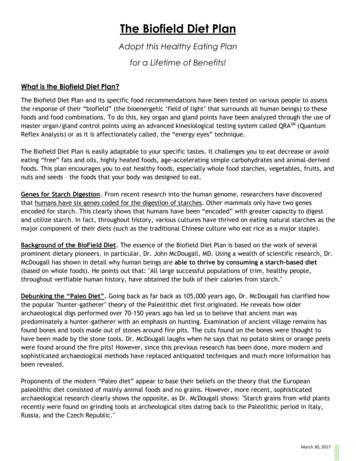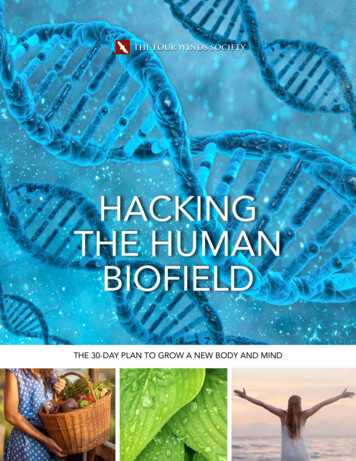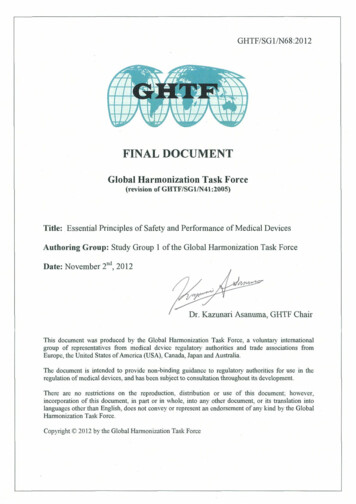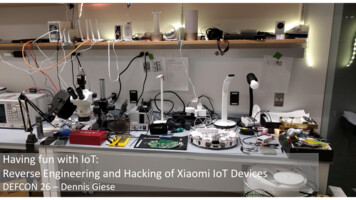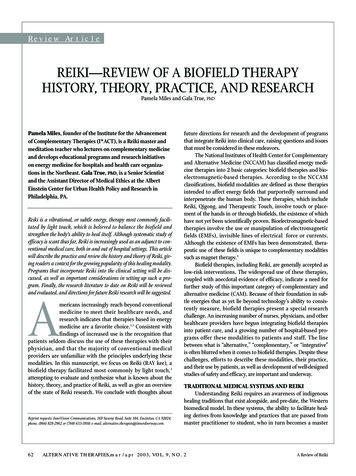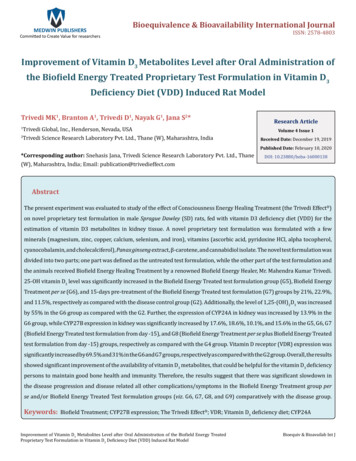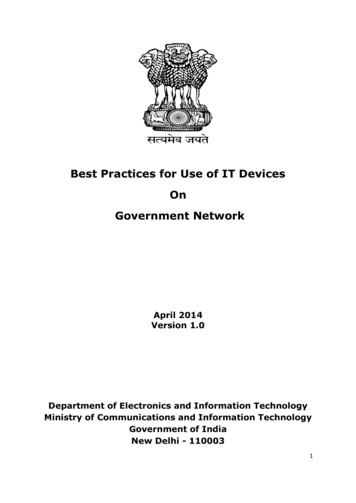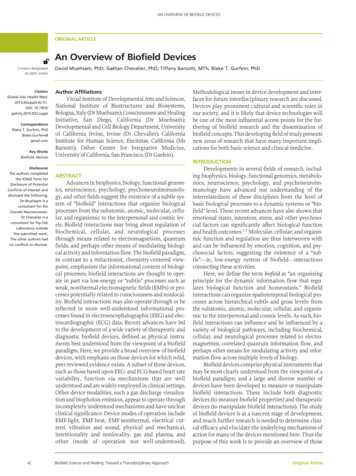
Transcription
An overview of biofield devicesoriginal articleAn Overview of Biofield DevicesContent designatedas open accessCitationGlobal Adv Health Med.2015;4(suppl):42-51.DOI: 10.7453/gahmj.2015.022.supplCorrespondenceBlake T. Gurfein, PhDBlake.Gurfein@gmail.comKey WordsBiofield, devicesDisclosuresThe authors completedthe ICMJE Form forDisclosure of PotentialConflicts of Interest anddisclosed the following:Dr Muehsam is aconsultant for RioGrande Neurosciences.Dr Chevalier is aconsultant for Psy-TekLaboratory outsidethe submitted work.The other authors hadno conflicts to disclose.42David Muehsam, PhD; Gaétan Chevalier, PhD; Tiffany Barsotti, MTh; Blake T. Gurfein, PhDAuthor AffiliationsVisual Institute of Developmental Arts and Sciences,National Institute of Biostructures and Biosystems,Bologna, Italy (Dr Muehsam); Consciousness and HealingInitiative, San Diego, California (Dr Muehsam);Developmental and Cell Biology Department, Universityof California Irvine, Irvine (Dr Chevalier); CaliforniaInstitute for Human Science, Encinitas, California (MsBarsotti); Osher Center for Integrative Medicine,University of California, San Francisco, (Dr Gurfein).Methodological issues in device development and interfaces for future interdisciplinary research are discussed.Devices play prominent cultural and scientific roles inour society, and it is likely that device technologies willbe one of the most influential access points for the furthering of biofield research and the dissemination ofbiofield concepts. This developing field of study presentsnew areas of research that have many important implications for both basic science and clinical medicine.IntroductionAbstractAdvances in biophysics, biology, functional genomics, neuroscience, psychology, psychoneuroimmunology, and other fields suggest the existence of a subtle system of “biofield” interactions that organize biologicalprocesses from the subatomic, atomic, molecular, cellular, and organismic to the interpersonal and cosmic levels. Biofield interactions may bring about regulation ofbiochemical, cellular, and neurological processesthrough means related to electromagnetism, quantumfields, and perhaps other means of modulating biological activity and information flow. The biofield paradigm,in contrast to a reductionist, chemistry-centered viewpoint, emphasizes the informational content of biological processes; biofield interactions are thought to operate in part via low-energy or “subtle” processes such asweak, nonthermal electromagnetic fields (EMFs) or processes potentially related to consciousness and nonlocality. Biofield interactions may also operate through or bereflected in more well-understood informational processes found in electroencephalographic (EEG) and electrocardiographic (ECG) data. Recent advances have ledto the development of a wide variety of therapeutic anddiagnostic biofield devices, defined as physical instruments best understood from the viewpoint of a biofieldparadigm. Here, we provide a broad overview of biofielddevices, with emphasis on those devices for which solid,peer-reviewed evidence exists. A subset of these devices,such as those based upon EEG- and ECG-based heart ratevariability, function via mechanisms that are wellunderstood and are widely employed in clinical settings.Other device modalities, such a gas discharge visualization and biophoton emission, appear to operate throughincompletely understood mechanisms and have unclearclinical significance. Device modes of operation includeEMF-light, EMF-heat, EMF-nonthermal, electrical current, vibration and sound, physical and mechanical,intentionality and nonlocality, gas and plasma, andother (mode of operation not well-understood).Biofield Science and Healing: Toward a Transdisciplinary ApproachDevelopments in several fields of research, including biophysics, biology, functional genomics, metabolomics, neuroscience, psychology, and psychoneuroimmunology have advanced our understanding of theinterrelatedness of these disciplines from the level ofbasic biological processes to a dynamic systems or “biofield” level. These recent advances have also shown thatemotional states, intention, stress, and other psychosocial factors can significantly affect biological functionand health outcomes.1-7 Molecular, cellular, and organismic function and regulation are thus interwoven withand can be influenced by emotion, cognition, and psychosocial factors, suggesting the existence of a “subtle”—ie, low-energy system of biofield—interactionsconnecting these activities.Here, we define the term biofield as “an organizingprinciple for the dynamic information flow that regulates biological function and homeostasis.” Biofieldinteractions can organize spatiotemporal biological processes across hierarchical subtle and gross levels: fromthe subatomic, atomic, molecular, cellular, and organismic to the interpersonal and cosmic levels. As such, biofield interactions can influence and be influenced by avariety of biological pathways, including biochemical,cellular, and neurological processes related to electromagnetism, correlated quantum information flow, andperhaps other means for modulating activity and information flow across multiple levels of biology.Biofield devices comprise physical instruments thatmay be most clearly understood from the viewpoint of abiofield paradigm, and a large and diverse number ofdevices have been developed to measure or manipulatebiofield interactions. These include both diagnosticdevices (to measure biofield properties) and therapeuticdevices (to manipulate biofield interactions). The studyof biofield devices is at a nascent stage of development,and much further research is needed to determine clinical efficacy and elucidate the underlying mechanisms ofaction for many of the devices mentioned here. Thus thepurpose of this work is to provide an overview of thoseOriginal Article
An overview of biofield devicesdevices that we judge to be promising enough to warrantfurther investigation rather than to provide a criticalreview. We believe a critical review is warranted but outof the scope of this paper.The biofield devices summarized here operatethrough a variety of modalities rather than a singlemechanism. Some biofield devices function throughwell-understood mechanisms and are already widelyused in clinical settings: for example, electroencephalography (EEG)- and electrocardiography (ECG)-based heartrate variability (HRV). Other devices appear to operatethrough mechanisms that are novel or incompletelyunderstood. However, all of these devices share a common property: rather than functioning primarily in areductionist, chemistry-centered manner, biofield devices function via the informational content of biologicalprocesses and can interact via low-energy or “subtle”processes, including those potentially related to consciousness and nonlocality.8,9Biofield DevicesHere we provide a brief overview of the broad categories of biofield devices, with the goal being to stimulate further discussion and research. It is out of thescope of this overview to assess the efficacy of particular devices. Rather, we describe those devices for whichwe deemed that sufficient evidence exists to warrantmention. In order to manage this task in a manuscriptof reasonable length, we chose to focus upon devicesfor which peer-reviewed scientific reports suggestingefficacy are available rather than conference proceedings or manufacturers’ white papers. However, in thefew cases that specific devices with sufficient promiseand relevance lacked a peer-reviewed basis, we havepresented whatever evidence was available. Here,devices are organized according to mode of operationand these modalities include electromagnetic field(EMF)-light, EMF-heat, EMF-nonthermal, electricalcurrent, vibration and sound, physical and mechanical,intentionality and nonlocality, gas and plasma, andother (mode of operation not well understood).Modalities Using Electromagnetic Fields: LightOne line of research that has yielded a largeamount of information on biofield activity is the studyof biophoton emission (BE), also called ultraweak photon emission. BE is the spontaneous emission of lightwhich emanates from all living organisms, includinghumans.10 Several studies have reported intercellularBE signaling,11 and it has been suggested that such signaling by coherent biophotons could explain manyregulatory functions,12 including cellular orientationdetection,13 biophoton-regulation of neurotransmitterrelease,14 leukocyte respiratory activity,15 andenhanced seed germination.16 A systematic review hassuggested that detection of BE may be useful as a medical diagnostic approach and as a research tool.17The body also exhibits sensitivity to exogenouslight exposure, and numerous phototherapies use visi-Original Articleble light to treat seasonal affective disorder,18 vitamin Ddeficiency,19 and a variety of skin conditions.20-24Infrared light has been used therapeutically for wound25and bone26 repair. Laser therapy (LT) is another form ofphototherapy that is now employed for a wide variety ofclinical applications.27 Low-level laser therapy (LLLT),which acts without ablating tissue, has been extensivelystudied, producing a growing body of systematic reviewssupporting efficacy of LLLT for several pathologies27including skeletal muscle repair,28 tendinopathy,29rheumatoid arthritis,30 osteoarthritis,31 neck pain,32chronic joint disorders,33 and traumatic brain injury.34Nonthermal LLLT appears to involve cytochrome c oxidase as the photoacceptor,35 further elucidating oneinstance in which the informational content of subtlelow-energy light-signaling may be more important thanthe physical energy of the input signal.Modalities Using Electromagnetic Fields: HeatDevices using infrared thermography (IRT), alsocalled infrared thermal imaging, can detect small changes in temperature due to muscular and metabolic activity, subcutaneous blood flow, and patterns of perspiration in specific parts of the body.36 Because of its highsensitivity, IRT can be used for a broad range of applications,37 including assessment of fever, complex regionalpain syndrome, Raynaud’s phenomenon, and cardiovascular disease. Although there is controversy regardingefficacy and clinical use, IRT has also been studied forthe detection of temperature changes due to inflammatory diseases and a variety of other syndromes,38 including breast cancer39,40 and vascular dysfunction.41 IRTcan provide real-time clinical data on functional metabolism without the use of radioactive dyes to identifylymphatic congestion and lymph involvement in angiogenesis related to malignancies.42 Other applications ofIRT have been useful in relation to angiology, allergology, rheumatology, plastic surgery,43 dermatology, orthopedics, diagnosis of circulatory abnormalities,44 andveterinary medicine.37 With respect to biofield andmind-body studies, IRT can be used as a tool to assesspsychophysiological activity,45 affective states in socialsituations,36,45 and diagnostic techniques related to traditional Chinese medicine (TCM).46 IRT may be viewedas both a subtle and gross measuring device.Modalities Using Electromagnetic Fields: NonthermalEMF interactions and electric currents, primarilycreated by ions within the body, are essential for a variety of critical biological functions, including regulation of ion transport, maintenance of membrane electrical potential, nervous system activity, cytoskeletaltransport, coordination of cell migration, embryonicdevelopment, and wound healing.47,48 Recent studieshave also shown that processes regulating the dynamics of mitosis, meiosis, and a variety of other processesare governed by electric fields generated within theintracellular network of microtubules, centrosomes,chromosomes,48-50 and nuclear chromatin.51 Also, EMFBiofield Science and Healing: Toward a Transdisciplinary Approach43
An overview of biofield devicessignaling in neuronal microtubules has been suggestedas a substrate for cognition50 and as a source of observedEEG correlates of consciousness,52 suggesting the existence of a system of subtle signaling that relies onrhythm, resonance, and synchronization.53,54In addition to these endogenous EMF interactions,biological systems appear to exhibit sensitivity to exogenous EMF exposures for most of the frequencies, fieldstrengths, and amplitudes occurring in natural and manmade environments.46,47 These observations have led tothe development of a large number of therapeutic applications and clearance from the US Food and DrugAdministration (FDA) and regulatory bodies worldwidefor EMF treatment of pathologies such as bone repair,pain, and edema.55Of particular relevance to biofield science, a largeand rapidly growing body of data has demonstrated theexistence of nonthermal EMF bioeffects, for which themolecular interaction energies are less than the averagethermal energy of the target.56 The existence of theseextremely weak EMF effects suggests the possibility ofbioinformation flow at extremely low energies andcould foreshadow a paradigm shift away from the biochemical paradigm and towards an information-oriented model, wherein weak signaling (via EMF, light, orvibration) plays an essential role in biological regulation.Pulsed electromagnetic field (PEMF) devices are themost common types of EMF therapy devices.57 PEMFdevices employ pulsed—ie, time-varying—waveformsthat are generally transmitted to the body via antennaenear the target tissue. Because of the extremely largebody of literature on PEMF therapies, here we shall consider only those pathologies for which sufficient numbers of clinical studies have permitted literature reviews.Treatment of nonunion bone fractures is one of themost widely adopted PEMF therapies cleared by theFDA.58 Other PEMF devices have been cleared by theFDA for pain and inflammation.59 PEMF treatment forosteoarthritis has been extensively studied, producingstatistically significant results, but recent reviews havesuggested that further research is needed to assess theclinical relevance of these findings.60-65 PEMF “resonance” or “bioresonance” devices are designed to function via resonances at frequencies characteristic of EEG,ECG, or other endogenous EMF processes. Although theconceptual basis for bioresonance is unclear and efficacyhas not been definitively demonstrated, bioeffects havebeen reported for some PEMF resonance devices.66-68Transcranial magnetic stimulation (TMS) is a formof pulsed magnetic field therapy that uses a rapidlychanging magnetic field to induce electric fields strongenough to stimulate cortical neurons and alter neuronalactivity.69 While TMS was initially used as an investigative tool in cognitive neuroscience,70 further inquiry hasled to its clinical use as an FDA-cleared treatment fortreatment-resistant depression.71-74 Now widely accepted as a noninvasive, low-cost method for brain stimulation, TMS has been reported to produce benefits for awide variety of psychiatric conditions such as depres-44Biofield Science and Healing: Toward a Transdisciplinary Approachsion, acute mania, bipolar disorders, panic, hallucinations, obsessions/compulsions, schizophrenia, catatonia, posttraumatic stress disorder, and drug craving.75TMS has also been studied as a treatment for neurological conditions such as Parkinson’s disease, dystonia, tics, stuttering, tinnitus, spasticity, epilepsy,stroke-related aphasia, and motor dysfunction andpain syndromes such as neuropathic pain, visceralpain, or migraine.75 Several clinical studies are underway to evaluate the clinical utility of TMS for theseindications,69,75-77 and a recent review has set forthevidence-based guidelines for TMS therapy and listedspecific conditions for which current evidence is sufficient or insufficient to recommend treatment.78Static Magnetic Field TherapiesA wide variety of health claims have been madefor static magnetic field (SMF) therapies, and a largenumber of manufacturers currently sell magnetsintended for therapeutic purposes.79,80 Most SMF therapies use ceramic or neodymium permanent magnetsplaced on the skin surface or very near to the body.Although the quality of published research variesgreatly, blinded in vivo studies have reported a varietyof clinical benefits for SMF exposures, includingimprovements related to postsuction lipectomy edemaand pain81; fibromyalgia pain and sleep disorders82,83;chronic pelvic pain84; pain, numbness, and tinglingdue to diabetic peripheral neuropathy85; postpoliopain86; and musculoskeletal pain.87 Other trials reported both positive short-term and negative long-termresults on osteoarthritis knee pain88 and no effect onfoot89,90 and chronic back pain91 (although the latter 2trials employed magnets in bipolar configuration,resulting in lower amplitude inside the target as compared to unipolar configuration). Reviews have produced ambivalent conclusions for analgesia92 andmicrocirculation93 and have reported that moreresearch is needed to determine clinical efficacy forbone, tendon, and skin healing.94Modalities Using Electric Currents, Voltages, orPotentialsAll living organisms produce electric currents andpotentials. This endogenous bioelectricity is a crucialcomponent of biology, as it serves as a substrate formembrane potential, all nervous system activity, andmany other vital biological processes.47,48 Pivotaladvances in medicine have resulted from the ability tomeasure and manipulate bioelectricity,95 and here weprovide examples of devices that measure or manipulate bioelectricity and have been employed for researchin biofield science. Even though their underlyingmechanisms are understood well, EEG and ECG areincluded as biofield devices. These approaches are sensitive measures of distributed information flowrequired for cellular regulation and function, whichalthough well understood in terms of biophysical substrates, also represent important examples of biofieldOriginal Article
An overview of biofield devicesinteractions according to the above definition.EEG is a noninvasive technique that uses electrodes on the scalp to produce quantitative information about the functional state of the brain. The frequencies present in EEG data are indicative of particular brain states and brain function on a cellular level.EEG is used to identify epileptic seizure activity andhas been employed as a research tool to measurechanges in brain state related to biofield therapies.96ECG, using skin surface electrodes in a mannersimilar in principle to EEG, is a diagnostic tool fordetecting the electrical activity of the heart. ECG issometimes used for the diagnosis of heart-related conditions, including myocardial infarction, syncope, andpulmonary embolism.97 ECG data can also be used tomeasure changes in HRV98-102 that have been linked toa variety of biofield practices, though further studiesare needed.103-105Electrodermal activity measured by skin conductance and galvanic skin response (GSR) reflects autonomic sympathetic arousal associated with emotionaland cognitive states.106 GSR measurements are alsoemployed by several devices claiming diagnostic abilities, but the veracity of these claims has not been clearlydemonstrated. Also, the use of GSR for diagnosis is controversial: while the FDA classifies GSR measurement asa Class II medical device to be used only for the measurement of skin conductance and permitted for use in biofeedback,107 a number of manufacturers of devicesintended for a broader range of diagnoses via GSR haveobtained FDA labeling under this more narrow designation. Another device employing electrodermal measurement is the apparatus for meridian identification (AMI),which measures electrical characteristics of the skin atacupuncture points located at the base of fingers andtoes called Jing-Well points.108 Based on the theory thatthe “energy” or “strength” of the acupuncture meridians(or energy channels) is reflected by electrodermal characteristics, conductance, capacitance, and polarization,measurements from Jing-Well points are analyzed inorder to diagnose a variety of pathologies, as well as toassess overall wellbeing.109 In a controlled study ofclaustrophobia therapy, increase in AMI-measured prepolarization current at Jing-Well points correlated witha significant reduction in anxiety.110 Similarly, statistically significant differences between electric potentialmeasurements obtained on and off acupoints andbetween external focus and healing states have beenreported in “energy healing” practitioners.111In addition to these diagnostic uses of bioelectricity, electrical stimulation is rapidly emerging as animportant new domain in medicine. Stimulation technologies, such as vagus nerve stimulation (VNS), deepbrain stimulation (DBS), and transcranial direct current stimulation (tDCS), are currently practiced clinically and are under investigation for several new indications, in particular for diseases and conditions thatare unresponsive to pharmacological therapy.VNS, which entails the use of implanted elec-Original Articletrodes to stimulate the vagus nerve, is currentlyapproved in the United States for treatment of epilepsyand depression and is being actively studied as treatment for osteoarthritis, tinnitus, anxiety, Alzheimer’sdisease, migraine, fibromyalgia, obesity, autism, sepsis,and inflammatory pathologies.112,113 DBS involves theuse of implanted electrodes to stimulate targetedregions of the brain.114 DBS has been studied as a treatment for chronic pain, major depression, and Tourettesyndrome115 and is currently FDA-cleared for the treatment of tremor, Parkinson’s disease, dystonia, andobsessive-compulsive disorder. It is also under consideration as a diagnostic/research tool.115 During tDCS,electrodes are placed upon the scalp to noninvasivelytransmit electrical current across the brain. Researchon tDCS is emerging and preliminary results suggest itmay enhance cognitive performance.116Earthing, also known as grounding, is a practicewhereby individuals connect themselves electrostatically to the earth by walking barefoot outdoors or byusing grounded conductive mats, bedsheets, or bodybands when indoors. Based upon the notion that theearth’s negative surface charge is a virtually limitlessreservoir of free electrons constantly replenished by theglobal atmospheric electric circuit,117,118 when earthed,the body uses these electrons as antioxidants for neutralizing excessive oxidative stress in the body.119,120Research published over the last decade reports a broadarray of health-related results, including improved sleep,decreased pain, normalizing effect on cortisol, reductionand/or normalization of stress, diminished damage tomuscles caused by delayed onset muscle soreness, reduction of primary indicators of osteoporosis, improvedglucose regulation, and enhanced immune function.121While this simple technique holds promise as a therapyand method for enhancing overall wellbeing, moreresearch is needed to determine the mechanisms andclinical significance of earthing.Taken as a whole, these electric current technologies, which alleviate symptoms by delivering electricalcurrent into a system that is experiencing dysfunction,produce systems-level effects and could be viewed ascutting-edge examples of biofield diagnostic and therapeutic devices. While still in the nascent stages ofrefinement and elucidation of mechanisms of action,the potential positive clinical impact of this class ofdevices is significant and likely to shed light upon several interrelated areas of biofield science.Modalities Using Vibration/SoundA number of devices use sound, both within andoutside of the audible range for humans. Infrasound islow-frequency sound with frequencies below 20 Hz,which is the limit of “normal” human hearing.Infrasound has been reported to be effective for increasing vitality, accelerating healing, and strengtheningimmune function.122Transcranial ultrasound (TUS) is a noninvasiveneuromodulatory technique that may be useful for theBiofield Science and Healing: Toward a Transdisciplinary Approach45
An overview of biofield devicestreatment of mental health and neurological disorders.123,124 While further work is needed to demonstrate the range of clinical applications,125,126 recentclinical studies have reported improvement in mood inchronic pain patients, suggesting promise for TUS as anoninvasive treatment for pain management and perhaps depression.127Several therapies using audible sound have beendeveloped that could be considered biofield devices.Music therapy, the clinical and evidence-based use ofmusical sounds to meet therapeutic goals, has beenshown to promote wellness, manage stress, alleviatepain, enhance emotional expression and memory,improve communication, and promote physical rehabilitation.128 Neuroacoustic therapies use sound to modulate brain activity and are reported to affect sympathetic-parasympathetic balance and synchronize the activityof the right and left brain hemispheres.129 Binaural beatneuroacoustic therapies employ combined tones ofslightly differing frequencies and left–right channels,which are reported to induce altered states of consciousness,130 modulate EEG activity and hypnotic susceptibility,131 and affect vigilance and mood.132Modalities Based Upon Mechanical/PhysicalInteractionsTCM uses acupuncture as a technique for balancing the flow of a vital energy called qi, believed to movethrough the body’s meridians.133 TCM posits that disruption of energy flow is a root cause of many types ofdisease134 and that one means to harmonize the flow ofqi is to insert thin metal needles into particular acupuncture points on the skin, often followed by stimulation of the needles mechanically or electrically.135Acupuncture is commonly used to treat many symptoms and diseases, including chronic pain, osteoarthritis, side effects of chemotherapy, and fibromyalgia.136-139 Although the anatomical nature of thesemeridians is unclear, it has been suggested that threadlike, nonlymphatic subcellular structures sometimescalled Bonghan ducts or primo vascular structures mayplay a role140,141; several theories for mechanisms ofaction have been put forth, including local inflammatory responses, cytoskeletal remodeling, release of adenosine (antinociceptive effects), neuromodulation,endogenous opioid production, and alteration of autonomic nervous system tone.142-145Modalities Based Upon Human IntentionA large and growing research literature has considered the role of human consciousness and intention inbiology, psychology, and the physical sciences.8,9 Thesehuman intentionality effects have been reported in avariety of living systems—for example EEG146 andgalvanic skin response147—suggesting that humanintention may play a key role in biofield interactions.Two large-scale projects are currently collectingdata on human interactions with global events: (1) theGlobal Consciousness Project is collecting data on cor-46Biofield Science and Healing: Toward a Transdisciplinary Approachrelations between statistics of continuously operatingrandom event generators around the world and briefepisodes of widespread mental and emotional reactionto major world events,148 and (2) the Global CoherenceInitiative is seeking to examine interactions of humanswith EMFs of terrestrial, solar, and cosmic origin byinstalling a global network of 12 to 14 ultrasensitivemagnetic field detectors around the planet and correlating EMF data with variables such as HRV.149 Whilethese global projects involve large numbers of participants around the world, the intention host device(IHD) is another type of device methodology basedupon human intention focused more individually.150The IHD has been reported to broadcast imprintedhuman intention to condition a laboratory environment and to produce alterations in time-series measurements of temperature, pH, drosophila fitness andenergy metabolism, in vitro enzyme activity, andmolecular concentration variability.150,151Modalities Using Gas or PlasmaGas discharge visualization (GDV) is an importantexample of the use of plasma in biofield science. Basedon the Kirlian effect, a high-frequency, high-voltage fieldis used to stimulate weak photon emission, followed bythe application of modern optics, electronics, and computer processing to form images of the weak photonemission. Dating back to the 1930s,152 this technique hasbeen called electrography,153 electrophotography,154corona discharge photography,155 bioelectrography,152GDV,156 electrophotonic imaging (EPI),157 andKirlianography.152 GDV/EPI techniques are currentlyused diagnostically based upon the characteristics ofimages of the fingertips158 and often with proprietarymeans of correlating these data with acupuncture systems or other means of assessing the biological state.159Nearly 1000 papers have been published (mostly inRussian) on GDV research and a few hundred more inthe West. A recent review of GDV research applied tomedicine and psychology can be found in the bookElectrophotonic Applications in Medicine: GDVBioelectrography.160 One study reported significant differences in cancer patient GDV scans when compared withhealthy particpants, and after 6 weeks of treatmentincluding surgery, chemotherapy, and radiation, achange trending toward healthy subject GDV profiles.161These intriguing data suggest that informatics basedupon biofield measurement devices such as the GDVmay be useful for gaining deeper understanding of disease states and guiding practitioners and their patientstowards states of greater wellness.Other Device ModalitiesIn light of observations of nonlocal effects,8,9which suggest that biofield interactions may involvemeans of information transfer that cannot be easilydescribed via well-understood substrates (eg, EMFs),here we describe devices that do not fit easily into thecategories listed above. Although a vast number ofOriginal Article
A
diagnostic biofield devices, defined as physical instru-ments best understood from the viewpoint of a biofield paradigm. Here, we provide a broad overview of biofield devices, with emphasis on those devices for which solid, peer-reviewed evidence exists. A subset of these devices, such as those based upon EEG- and ECG-based heart rate

